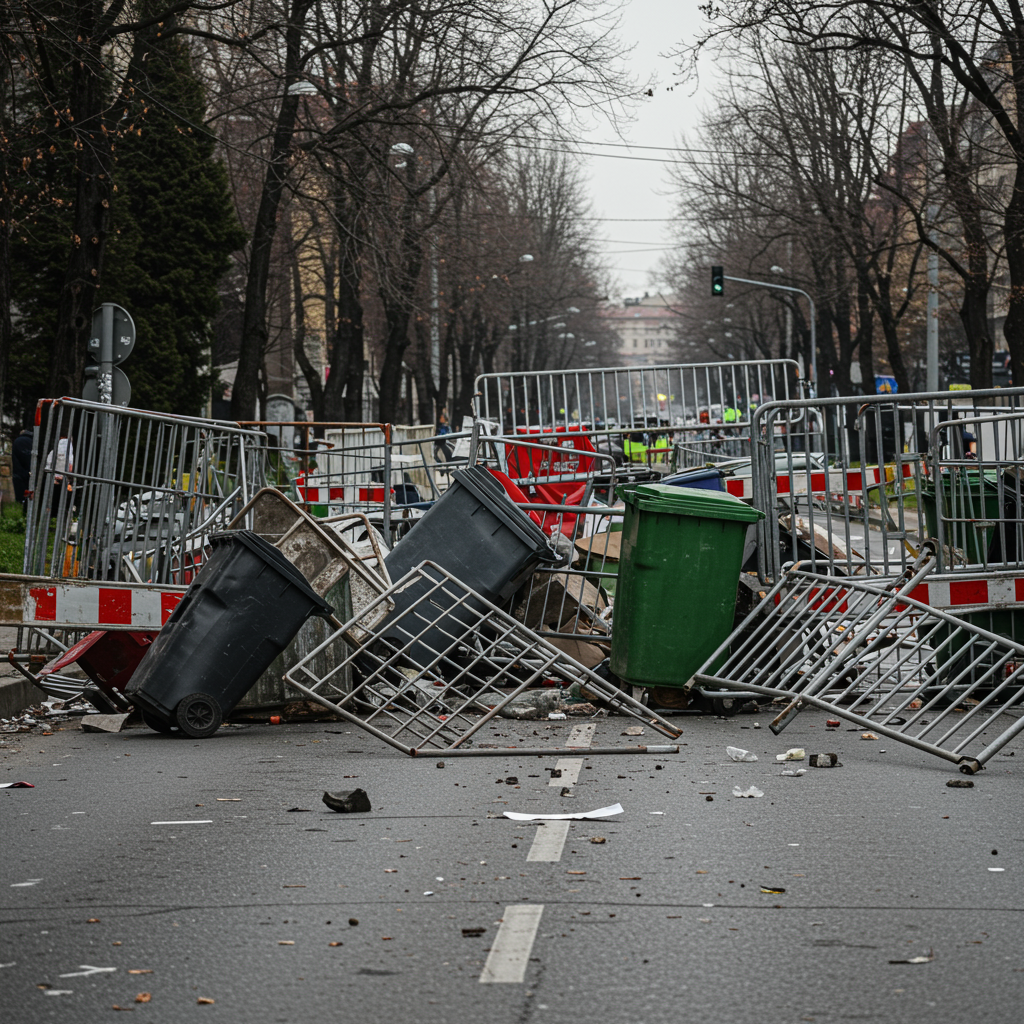Serbia plunged into a new wave of tension this week as thousands of anti-government protesters erected street blockades across the nation. This dramatic escalation follows a weekend of intense clashes between demonstrators and police during a massive rally in Belgrade, resulting in dozens of arrests. The blockades, some involving metal fences and garbage containers, appeared late Sunday and continued into Monday, signaling a defiant response to the government’s crackdown and a persistent demand for systemic change and accountability.
Widespread Disruption Follows Belgrade Clashes
The blockades quickly spread beyond the capital. In Belgrade, protesters strategically obstructed key thoroughfares and a vital bridge spanning the Sava River. Reports from other Serbian cities confirmed similar actions, including in the northern city of Novi Sad, where demonstrators reportedly targeted offices of the ruling Serbian Progressive Party by pelting them with eggs. These synchronized actions highlight the widespread nature of the discontent simmering across the country. The blockades aim to disrupt daily life and pressure authorities into meeting protester demands.
Demanding Release and Early Elections
At the heart of the immediate unrest is the demand for the release of dozens of individuals detained during Saturday’s protest. University students and other participants were among those jailed, facing serious accusations ranging from attacking law enforcement officers to allegedly plotting to overthrow the government. Protesters insist that these arrests are politically motivated and unjustifiable. Beyond the immediate demand for releases, a central call from the months-long movement remains constant: the demand for early national elections. Organizers had issued an “ultimatum” for president Aleksandar vucic to call a snap vote before Saturday’s rally, a demand he has repeatedly rejected.
Anatomy of a Weekend of Confrontation
Saturday’s rally in Belgrade drew tens of thousands, one of the largest turnouts in the sustained wave of dissent that has challenged President Aleksandar Vucic’s administration for nearly eight months. While authorities estimated the crowd size at 36,000, an independent estimate by the Archive of Public Gatherings put the figure significantly higher, at approximately 140,000. Protesters voiced long-standing grievances, declaring the current government “illegitimate” and attributing any violence that occurred to the actions or inactions of the authorities.
Clashes erupted following the official conclusion of the rally. Law enforcement officers reportedly deployed pepper spray, batons, and shields to disperse crowds, while some protesters responded by throwing rocks, bottles, and other objects. The confrontation resulted in injuries on both sides. Authorities reported that 48 police officers were injured, with one seriously hurt according to one source summary. Twenty-two protesters sought medical help, with two described as seriously injured. Initial police reports indicated 77 arrests on Saturday, with Interior Minister Ivica Dacic confirming 38 remained in custody by Sunday, predominantly facing criminal charges. Prosecutors added that at least eight more individuals were detained on Sunday.
Roots of the Resentment
The current wave of anti-government demonstrations gained significant momentum in November 2024 following a tragic event in Novi Sad: the collapse of a renovated rail station canopy that killed 16 people. This disaster became a potent symbol of what many in Serbia view as systemic corruption and negligence within state infrastructure projects. The tragedy fueled widespread anger and demands for accountability, evolving into broader calls for political reform and an end to perceived authoritarian rule. University students have played a particularly active role in mobilizing and sustaining the protests.
President Vucic Responds with Defiance
Addressing the situation on Sunday, President Aleksandar Vucic took a firm stance against the protesters and their actions. He announced the arrests, accusing the rally organizers of inciting violence and attacks on police. Vucic vowed that “many more arrested for attacking police” were coming, asserting that identification of involved individuals was ongoing. He used strong language, referring to some protesters, including University of Belgrade head dean Vladan Djokic, who was present at the rally, as “terrorists” attempting to “bring down the state” or “violently change the state order.”
Vucic remained resolute against the central demand for early elections. He reiterated that national elections would not be held before the end of 2026, dismissing the pressure from the streets. The President claimed victory for the state, stating, “Serbia won. You cannot destroy Serbia with violence,” and accused protesters of consciously seeking bloodshed. He warned that “the time of accountability is coming,” signaling a potential further crackdown. Vucic has also repeatedly alleged, without providing specific evidence, that the protests are part of a foreign conspiracy aimed at destabilizing his government.
An Increasingly Authoritarian Climate?
Critics argue that Vucic, who has held prominent government roles for over a decade (including Deputy PM and PM before becoming President in 2017), has systematically consolidated power and become increasingly authoritarian. They accuse his administration of stifling democratic freedoms, suppressing independent media, and allowing corruption and organized crime to flourish – charges Vucic vehemently denies. The recent pattern of arrests preceding large demonstrations is cited by some as evidence of a routine crackdown on dissent. Despite formally pursuing European Union membership, Vucic’s government has simultaneously nurtured close relationships with both Russia and China, a policy that adds another layer of complexity to Serbia’s political landscape.
The clash of narratives is stark: Protesters view the government as illegitimate and accountable for the violence, while President Vucic labels protesters as violent instigators and terrorists. The current street blockades represent a dangerous escalation, pushing Serbia’s political crisis to a critical juncture. With the government refusing demands and promising more arrests, and protesters vowing to continue their actions, the immediate future appears fraught with uncertainty and the potential for further confrontation.
Frequently Asked Questions
What triggered the current street blockades in Serbia?
The street blockades were primarily triggered by the mass arrests of anti-government protesters following clashes with police at a large rally in Belgrade on Saturday. Thousands took to the streets and blocked roads on Sunday and Monday, demanding the release of those detained and expressing continued frustration with the government.
Why have anti-government protests been happening in Serbia for months?
The ongoing protests in Serbia, which have lasted nearly eight months, were initially sparked by the collapse of a train station roof in Novi Sad in November 2024, resulting in 16 deaths. This tragedy is widely seen as a consequence of systemic corruption and negligence in state projects. The movement has since grown to encompass broader demands for accountability, an end to perceived corruption and authoritarianism, and calls for early national elections.
How has President Aleksandar Vucic responded to the recent protests and blockades?
President Aleksandar Vucic has strongly condemned the protesters, accusing organizers of inciting violence and acting as “terrorists” trying to overthrow the state. He announced more arrests would follow the initial detentions from Saturday’s rally. Vucic has also firmly rejected demands for early elections, stating none will be held before 2026, and claims the protests are part of a foreign plot.



